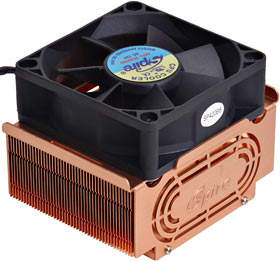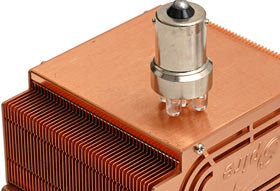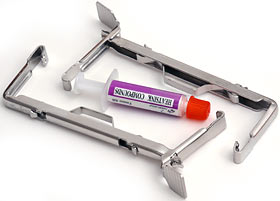
Quick Shot review 14:
Spire SP420B8 CopperStream P4 CPU cooler
Review date: 18 December 2003.
Last modified
03-Dec-2011.
The after-market Pentium 4 CPU cooler business has a problem. The problem is that Intel's stock coolers for Pentium 4s are actually pretty darn good.
This isn't because the stock coolers are especially revolutionary in design. The high-end copper-cored ones with the swirly fins are nice, but coolers like that have been around for a couple of years now.
The stock coolers don't have especially powerful fans, either. Below three watts rated power, and rather less again for their actual run power, after spinning up. Since the fans are 70mm slimline units, this doesn't add up to huge airflow.
No, the stock coolers work well simply because they're big, and have a big contact patch to the processor.
The Socket 478 (and old Socket 423) mounting frame gives the cooler a lot of space. Socket A/370 heat sinks have to be built taller than P4-socket sinks to get in the same amount of metal, and that's not efficient; the further a fin gets from the base of the heat sink, the less good more metal does.
The P4 socket's solid retention mechanism also means the poor little socket doesn't have to take the load of the cooler, so big chunks of metal can sit on the CPU without endangering the life of the motherboard.
Sure, Socket A coolers can bolt onto the board; see the Thermalrights I checked out the other day here, for instance. But installing a bolt-mount cooler isn't a 30 second job. Only the most exotic P4 coolers require you to change the retention frame.
The large P4 contact patch makes a big difference, too. A small contact patch processor like an Athlon, Duron or old Socket 370 P-III can make excellent thermal contact with a heat sink, if the sink base is very flat and the thermal interface material is of reasonable quality (lousy thermal goop generally starts out working fine, then dries out and goes bad), and correctly applied. But increasing the size of the contact patch with a big metal heat spreader integrated into the processor package makes the quality of the interface, per unit area, less critical.
This all means that P4 users can get along like P-III and Celeron users back in the pre-P4 days. Just use the stock cooler with its standard pre-applied "chewing gum" thermal goop, and you're likely to be OK. If you want more performance, remove the standard goop and use a smear of grease instead. That'll probably do, as long as your case has decent ventilation. If it doesn't, then you should be fixing the case, not the CPU cooler.
(And it won't necessarily cost you much to fix it good and proper.)
All this said, though, there are still reasons to buy a third party cooler.
Perhaps you want to really push the overclocking envelope, for instance. Current high end P4s manage better than 90 watts Thermal Design Power at stock speed, and you can be talking more than 110 watts with a small voltage boost and a 15% overclock.
Maybe you want a quieter-than-stock cooler. Stock P4 coolers don't make much of a racket, but they don't cut it for the silent computing crowd.
Maybe you just bought an OEM P4 that didn't come with a cooler. Most people (pretty much everybody, here in Australia) buy retail-packaged P4s and Celerons, but OEM chips are out there too.
And maybe, of course, you just want a pretty cooler.
Behold, a contender in every category.
The Spire SP420B8 CopperStream is a P4 cooler with a thin-fin all-copper heat sink (tastefully embossed with the Spire logo on its cut-out sides), a conventional clip-on retention system, and a very quiet full height (25mm tall) 70mm fan.
Like all whisper-quiet fans, the one on the SP428B8 is very low power. It draws only about 60 milliamps from 12 volts after it's spun up, and even if it's stalled (when brushless computer fans draw the most current) it only sucks down about 150 milliamps. In normal use, this is about a three-quarter-watt fan, at most, despite its rated power of 0.96W.
A fan this gentle doesn't need a finger guard, so it doesn't have one. This means you'll need to keep cables away from the top of the CPU cooler, so they don't get damaged by the fan or, more probably, jam it. But you should be doing that anyway; above the CPU cooler is the worst possible place for a cable-snarl to be.
Because the fan's a full height unit, it can actually move a decent amount of air. It's rated for more than 22 cubic feet per minute, which it won't come close to achieving when it's pushing air through the close-packed fins of this heat sink. But it still does all right.
It's also a ball bearing fan, by the way, and its lazy 2500RPM rotational speed means its 50,000 hour lifespan rating is quite plausible. Most people don't go five years and eight months between major CPU upgrades.
Here in Australia, Lownoise PC are selling the SP420B8 for $AU45, plus modest postage within Australia. That's a good price for a copper-sink cooler of this type.
The base of the SP420B8 is flat and quite smooth, and has a bit of a polish on it, as you can see from the reflection of the thing I should have reviewed by now. True cooling zealots may yet wish to whip out their optically flat granite slab and 10,000 grit diamond paper and impart to the base of the heat sink a polish adequate for laser weapon test purposes, but you shouldn't expect a massive increase in performance if you do.
Thanks to its plethora of fins as much as to its copper slab base, the SP420B8 weighs about 508 grams, including its fan but not including the mounting hardware. As mentioned above, though, cooler weight doesn't matter much for P4 boards. As long as you don't have a really tall cooler that offsets the weight a mile from the board, you can easily get away with using a big brick of metal.
Along with the CopperStream, you get a little tube of unpretentious white thermal goop (better than the frequently seen el cheapo Bag O' Grease, but probably not the best choice for long term durability; try cheap premium grease instead). There are also a couple of normal three-part retaining clips, suitable for installation either way around with your Mark 1A Hand. That's another of the advantages of P4 heat sinks; you never have to push a clip into place with a flathead screwdriver, while praying that the thing won't pop out and gouge your motherboard.
Performance
OK, so does the CopperStream work?
Yes, it does. Very well, actually, considering the fact that the thing's barely audible. It scored 0.44°C/W according to my standard cooler comparison testing protocol, and using the P4 contact patch plate on my CPU-simulating heater.
0.44°C/W is more than good enough for quite serious overclocking, if you've got good case ventilation. In a lightly ventilated low-noise case, the CopperStream should be perfectly happy cooling even the highest-spec P4s at stock speed.
Overall
Copper air coolers for all PC CPU socket types seem to be evolutionarily tending towards the thin-fin design, these days. The manufacturers have all licked the problem of making a copper cooler with lots of super-thin fins that won't go squish when you put a fan on it, and the massive surface area that this design yields gives these coolers considerably superior performance to the old thick-fin copper designs, like the venerable Kanie Hedgehog. Per square centimetre of fin/pin area, thin-fin sinks aren't as good as the old chunky designs, but they've got so much more fin area that they end up winning by a large margin.
The SP420B8 heat sink is a fine example of the breed. The heat sink is what lets this peaceful little fan turn in cooling results better than those of ludicrous finger-smashing monster-fans on the over-engineered pin-fin aluminium heat sinks that people used to think were cool.
Accordingly, I like this cooler a lot. Recommended.
Review SP420B8 kindly provided by Lownoise PC.




